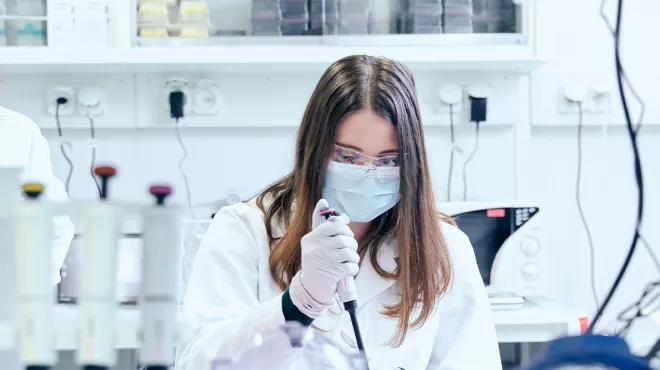Immunotherapies for cancer have been life-changing for patients who respond to them. Yet, overall, only about 20% of patients respond to these drugs. To expand the reach of these medicines, approximately 1 100 clinical trials have been launched by companies and research institutions over the past few years to test them in a range of combinations.
This is a huge number of clinical trials – each taking up the time and resources of physicians, hospitals, scientists and patients. Companies have taken a shotgun approach, simultaneously launching trials of a wide range of combination therapies, says Glenn Dranoff, Global Head of Immuno-oncology at the Novartis Institutes for BioMedical Research (NIBR). And it’s not sustainable. There are too many drugs and too many possible combinations, and perhaps most importantly, there isn’t enough knowledge about how immunotherapies work in cancer.
So researchers at Novartis have launched a comprehensive research program designed to systematically inform the selection of smart combination therapies. Through the program, the team has generated preliminary evidence that two experimental immunotherapies, LAG525 and spartalizumab (also called PDR001), show early clinical activity in some cancers, though more clinical investigation is required.
“Combinations will be important going forward”, says Catherine Sabatos-Peyton, an immunologist at NIBR. “How do we smartly combine our drugs for patients? Answering this question is the goal of our program”.
The research enlists the help of every patient who enrolls in an immunotherapy clinical trial run by NIBR – an effort that might engage hundreds of patients. Researchers examine tissue from these patients and look for signals that will help them identify differences between those who respond to a given therapy and those who don’t. The scientists are taking a wide-eyed approach in an effort to ensure that no signal will be missed. By going beyond the current assumptions about how cancer therapies work, Novartis aims to move toward a scientifically guided rationale for choosing smart combinations of cancer therapies.
“What is important now is discovery”, says Dranoff. “We’re taking an unbiased view of what’s happening in our patients and bringing the best discovery tools available to understand why some people respond to immunotherapies and some do not”.
Study of combos
Novartis launched a clinical trial of the compounds LAG525 and spartalizumab in patients with solid tumors a few years ago. The thinking was that these compounds might work together because they both lift brakes on immune cells called T-cells. Preclinical experiments in animal models of cancer suggested that these two therapies could potentially lead to greater anti-tumor effects.
T-cells normally attack foreign or diseased cells. But sometimes receptors appear on the surface of the T-cells and act as brakes to keep them from going haywire. “These brakes dampen the immune system before it damages healthy tissue”, says Sabatos-Peyton.
Tumors have learned to protect themselves from the immune system’s cancer-fighting power by sending out signals that increase this built-in braking action.
So-called checkpoint inhibitors like LAG525 and spartalizumab aim to remove the brakes. For instance, spartalizumab targets PD-1, the most well-known checkpoint receptor. The majority of the approved immunotherapies for cancer so far target PD-1 or its binding partner PD-L1. LAG525 targets LAG-3, which most often appears on the surface of a T-cell alongside PD-1, almost like an emergency brake.
Researchers suspect that the presence of LAG-3 could undermine the effects of anti-PD-1 therapy, potentially explaining cases where patients don’t respond to PD-1 inhibitors or relapse after taking them. “This is why combination therapy has the potential to be potent”, says Sabatos-Peyton. “The compounds might release the brakes on two sides”.
Early clinical data from this small trial showed responses in some patients with triple-negative breast cancer. But Sabatos-Peyton’s team wanted to go beyond their original thinking and learn more. The human immune system is incredibly complex, and they suspected that LAG-3’s role might not be limited to braking alongside PD-1.
So they connected their trial with the larger research program at NIBR to understand more about how these immunotherapies work in patients. Deep study of patient samples from this trial suggests that the two agents together might potentially stimulate an immune response in certain tumors in multiple ways. Tissue from the patients who responded to the combination therapy showed enhanced immune activation – specifically an increase in specialized forms of T-cells after therapy. These preliminary findings, which are helping the team identify patients who might benefit from the combination, were presented at the American Society of Clinical Oncology (ASCO) Annual Meeting on June 4, 2018, in Chicago, Illinois, in the US.
We’re taking an unbiased view of what’s happening in our patients and bringing the best discovery tools available to understand why some people respond to immunotherapies and some do not.
Glenn Dranoff, NIBR Global Head of Immuno-oncology
The team is continuing this research effort to better understand how the combination influences the immune system. “This research is critical for our understanding of the mechanisms of the agents we’re already investigating and also for discovery of what we need to be doing that we aren’t”, says Sabatos-Peyton.
Systematic study
This comprehensive research program encompasses studies of all the therapies Novartis is developing for cancer, including immunotherapies and therapies that target molecular pathways in tumors, called targeted therapies. “What we learn will help us to rank and prioritize the combinations and help us design the next generation of medicines”, says Peter Hammerman, Global Head of Oncology Translational Research at NIBR.
The researchers take in clinical samples from patients enrolled in NIBR trials. They study human tissue in addition to using animal models because the mouse immune system does not always work the same as the human immune system. The tissue, taken before and after treatment, includes not just tumor cells but also surrounding cells so that immune cells and signals can be studied.
Hammerman’s team sends the samples to NIBR’s next-generation diagnostics team for analysis. The diagnostics include RNA sequencing (RNAseq), which reveals which genes have been turned up or down by the cancer or in response to a drug.
RNAseq is employed across the industry, typically using tools that focus on analyzing a limited set of genes. But NIBR researchers have developed technology that enables researchers to examine gene expression across the entire genome for large numbers of samples. Using this approach, no change in gene expression levels should be missed. Unbiased RNAseq enabled Sabatos-Peyton’s team to make their early observations of enhanced immune activity with combination immunotherapy using LAG525 and spartalizumab.
The scale of the challenge of selecting smart combinations might best be appreciated by considering that Novartis currently has over a dozen immunotherapies in its pipeline. Those experimental medicines are supported by about a hundred immunologists who are working on understanding them and discovering more. Hammerman’s team is also learning that targeted therapies might also influence immune cell behaviors, so they could be viable partners for immunotherapies.
“There’s a long way to go”, says Hammerman. “If we’re successful, our work will lead to combinations of compounds that add to the efficacy of immunotherapy broadly across patients. And we will have used a scientific approach to get there”.
Main image: Immuno-oncology activates T-cells to recognize and attack a tumor cell. Image by Mark Mazaitis
Learn how Novartis is working to build smart combinations of #cancer drugs. #ASCO18



